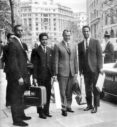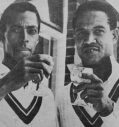An Interview With Lance Gibbs, Part 2
Pratham Chhabria |
If you haven’t read Part 1 of Pratham’s interview you can do so here
Pratham: So before we get into your international career, there are some general cricketing questions I have. Like you said, there’s a lot of things you picked up and you filtered out. I’m curious to go behind the curtain and identify some of the things you picked up on.
Pratham: So the first thing is…when you were bowling, was there a particular field you preferred your captain set for you?
Lance Gibbs: Yeah – if I get a certain amount of turn, I would have more men on the leg side then the off-side.
Pratham: Cause you’d be turning it in that direction…
Lance Gibbs: Yes – because when facing a right hander, you have to work it out.
Pratham: Till the end of the early phase of your career, 59′-60′, they didn’t have that rule in place that you could only have a couple of fielders behind square. So you could have close in fielders, multiple short legs, on the leg-side. Did you in your early days bowl a lot with fielders right around the bat, multiple short legs, that sort of thing?
Lance Gibbs: Depends on how much turn you are going to get. That’s the key to it. If you are getting a certain amount of turn, you don’t want 5 men on the off-side when bowling to the right hander – cause he’ll wait for the ball and hit it that way. If I’m bowling to the right hander, I would go on to bowl more straight. You bowl accordingly.
Pratham: And with left handers, did you always have a slip in, or try to have one in?
Lance Gibbs: Oh yeah. Slip? More than one slip too! (laughing)
Pratham: Did you ever have a gully or more fielders behind the off-side for the left hander?
Lance Gibbs: I would adjust accordingly to what turn I’m getting and do that.
Pratham: So that’s really nice cause it plays into a question I had for you based off the turn you’re getting, based off the pitches you were playing on. Cause obviously a lot of these questions are contingent on the surfaces…
Lance Gibbs: The turn, yeah.
Pratham: So how would you vary the way you bowled when you were bowling on different types of pitches? Say you were playing on a greentop…
Lance Gibbs: I wouldn’t get as much turn on a green-top cause when you bowl it’s going to hit the pitch and you’d expect it to turn as much but it’s not going to. It will go straight on.
Pratham: In that situation, would you change your length? Would you look to bowl fuller? Shorter, length-wise?
Lance Gibbs: No…I would concentrate on bowling nearly the same way that I bowled but adjust accordingly. Whether I’m going to grip it hard and put everything into it or not.
Pratham: Say you weren’t playing on a greentop but you were playing on an absolute road, a flat wicket. The one where you get a 600 vs 600 scoring game. I’ve heard there were quite a few pitches like that in your day in the Caribbean…
Lance Gibbs: Mm-hmm, mm-hmm.
Pratham: So obviously you’re not getting much turn there…
Lance Gibbs: My approach there would depend on the batsman. Every batsman’s got strength and weaknesses. You’d need to concentrate on his weakness and bowl accordingly. Not because he’s an aggressive scorer on a flat pitch, you’re going to be afraid to bowl at him the way you should.
Pratham: So those are instances where you aren’t getting turn. If you are getting turn – if the pitch is turning, would you look to bowl a wider line?
Lance Gibbs: A wider line at times, and I’d take off the amount of turn at times to capitalize on it.
Pratham: In terms of modes of dismissal you were looking, on say like the green top or flat pitch, would you look more towards trying to get somebody out caught or stumped more than say when you were bowling on a turning surface? Obviously – it would depend on the batsman, but would there be some mode of dismissal you would lean towards trying to get more depending on the surface?
Lance Gibbs: Yeah, yeah. It would depend on the surface a lot. There’s also times where you’d bowl particularly well on a turner and not get as many wickets as you hope. So it’s up to your as a bowler to adjust to the conditions quickly and work accordingly.
Pratham: So we talked about different types of surfaces in terms of the turn is there – but turn’s one factor. If the ball’s turning but it’s coming at a very slow pace, it gives time for the batsman to adjust…
Lance Gibbs: You know…if it’s the left hander – I’m bowling. I’ve got Sobers bowling on the other end. He’s bowling to the right hander. So you’ve got to be able to adjust accordingly. I’d even turn to Sobie and say leave a mark outside the off-stump instead (hahaha)
Pratham: In those days, were the umpires very particular about you running on to the pitch?
Lance Gibbs: No, no, no. And I played with my boots with the pegs pretty low, so I could have run on any part of it.
Pratham: And it wouldn’t have damaged the pitch…Was that the same with your other West Indian mates and cricketers? Did they also play with boots with these kind of pegs?
Lance Gibbs: Some got bigger boots and spikes then others.
Pratham: If the wicket didn’t offer you much turn but it the pitch was quick, did you feel more comfortable on bowling on that or a wicket was slow but that was turning?
Lance Gibbs: You have to adjust conditions as a bowler. And the more you adjust to conditions, they better for you.
Pratham: So you basically treated it all equal.
Lance Gibbs: Yeah.
Pratham: Let’s come on to something I think will be of fascination to a lot of people watching. There are a lot of young impressionable cricketers who are off-break bowlers who want to learn the tricks of the trade, the arts, the craft involved. And over your 20 year old career, there were a lot of things I’ve seen footage of you do which were different. The ball came out in different ways and so forth. I have a cricket ball with me. Can you walk us through the grips you would use to achieve certain things?
Lance Gibbs: That’s a legspinner (demonstrates grip of leg-spinner). This is the off-break. I spin it through there. That’s off-break leg-break. Straight ball – I’d hold on the seam. You push it. When the ball hit the seam, it’s going to go straight on.
Pratham: Would you tweak the positioning of some of those fingers time to time to confuse the batsman to think there was a new type of delivery?
Lance Gibbs: Yeah – but the batsman is not going to see anything until I deliver the ball.
Pratham: Did you sometimes hide the ball? There was a famous bowler from Pakistan, Wasim Akram. He would keep the ball hidden till the last moment when he was reverse swinging the ball. Did you try to do something like that?
Lance Gibbs: I tried to do everything, everything.
Pratham: There is something remarkable about your career. You bowled 27115 deliveries during….
Lance Gibbs: 27000? That’s all? (laughing)
Pratham: In your Test career, I’m sure you bowled a lot more at first class level. But I computed what that would be in terms of your workload per match. It came out to a figure of 58 overs per game. So about 29 overs per innings, depending on whether there were 2 innings or not. I did some statistical readings, and you were the fifth more utilized bowler by your captain and side in Test history. How did you manage to deal with such a incredible workload?
Lance Gibbs: Well I was a professional cricketer. Therefore, I tried to do everything that was right. And probably bowling as much as I did was the right thing. I’m not going to make runs. I’m going in at number 11. So therefore, I was dependent on bowling.
Pratham: Getting to know you more and seeing you in person, you’re a lean athletic man, still. Were there types of exercises you would go about doing?
Lance Gibbs: I ran 7 miles, every day. I just figured that running was the most important thing. If you are particularly fit, you will be able to help your team.
Pratham: And then, your diet. These days, you have dieticians in every national side to try to make sure you’re eating the right things to make sure you can perform on the field. What was your diet like at home versus when you were playing abroad?
Lance Gibbs: Well, it’s up to you to see what is being offered and see what best to take and what best not to take. I was that type of individual – I would pick and choose.
Pratham: Were there any meals you gravitated towards?
Lance Gibbs: Not really.
Pratham: Now I see your fingers now – they look very good now. But there was a photo I saw of yours from 68′-69’…
Lance Gibbs: Bulging! Yeah yeah yeah. (Holds index spinning finger)
Pratham: Yeah.
Lance Gibbs: As always, you can tell I don’t play anything now (laughing)
Pratham: What was that way you tried to fix that sore finger? Was there a particular ointment or something you would try to apply?
Lance Gibbs: Salt. Pack it. Hope it comes out best.
Pratham: And you know for any bowler, let alone a finger spinner who relies so much on his fingers so much, it’s going to be difficult to push yourself to play through that discomfort cause everything you’re bowling that finger’s going to aggravate. Were there ways mentally, psychologically, or physically that you get through this spell?
Lance Gibbs: Instead of using the bottom of my spinning finger, I’d use the top. From this here, I wouldn’t get as much turn but I could still help my team – which is the important thing.
Pratham: And that would have necessitated you probably bowling differently too cause you wouldn’t be able to get as much turn.
Lance Gibbs: Exactly! But there were times where you don’t know if the batsman would be able to pick that up!
Pratham: And were there times where you gave off the impression that you were really try to rip the ball and bowling an off-break…
Lance Gibbs: Where nothing was being produced? Right. You’d get wickets sometimes that way too!
Pratham: Did you ever have a bowl that you would try to bowl seam up? Instead of trying to spin the ball, were there times you tried to seam or swing the ball?
Lance Gibbs: Yeah, yeah. I opened the bowling as well!
Pratham: I know some spinners will throw that in as a variation.
Lance Gibbs: Yeah.
Pratham: If you were timed on a speed gun and say you were bowling your stock off-spinner, what would be the range of your bowling speeds? Would it be around 80-85 kilometers per hour?
Lance Gibbs: I would say that.
Pratham: And your leg-break, was it slower than your off-break? Was it the same pace?
Lance Gibbs: Well it depended on the batsman.
Pratham: And when you were bowling the straighter you had showed earlier…
Lance Gibbs: Variation was an important thing of that time.
Pratham: Did you prefer your straighter one quicker through the air?
Lance Gibbs: Quicker. Because it’s not going to turn. So might as well push it through.
Pratham: When you played against the right hander, would you look to bowl over the wicket? Or would prefer to bowl around the wicket to the right hander?
Lance Gibbs: I was never particularly good at bowling around the wicket. I prefered to use whatever I’ve got in front of me (demonstrating different parts of the over the wicket crease).
Pratham: But were there times you would do that as a variation?
Lance Gibbs: Yeah – but it wasn’t successful. Having said that, variation is the spice of life.
Pratham: Against left handers, would you ever look to bowl around the wicket to them?
Lance Gibbs: No no no. I’d bowl the same way.
Pratham: And how would you work the crease during a bowling spell?
Lance Gibbs: (Gesturing to a hypothetical crease and stumps) So you’ve got this part (the crease from over the wicket). You’ve got the stumps. And then you’ve got the other part (demonstrating part of the crease from around the wicket). And you work it accordingly. So if you’re going to bowl it from here (widest part of the crease available from over the wicket to off-spinner for a right hander), that’s your variation (moving hand multiple successive times to indicate slowly moving to end up close to the stumps and then from close to the stumps to wide of the stumps) there.
Pratham: What was motivating you to go wide of the crease? Was it based off turn?
Lance Gibbs: If I went wide of the crease, it wasn’t going to turn. Not going to turn as much for me as if I was bowling in my spot (gesturing to a midway point in the crease).
Pratham: Conversely, if you were going close to the stumps, were you looking not to turn the ball because it would only have to do as much to hit the stumps?
Lance Gibbs: You’re not going to turn the ball as much from there. But at the same time , the umpire’s there. He’s going to tell you if you’re getting too close to the stumps.
Pratham: You did have an interesting action. A lot of spinners would have a more elongated runup. You always seemed to go from a couple of paces and almost jump into your delivery stride. And it was all chest on. They would often recommend spinners getting into a side on position. Did that develop naturally? Were their benefits of you doing that compared to other spinners?
Lance Gibbs: (laughing) I never really looked at it much. That’s a question I’ve never been asked before!
Pratham: I guess that’s just something that interests me, I guess (laughing).
Pratham: Did you ever concentrate on landing the ball on leg stump? Or was it always on off-stump?
Lance Gibbs: I bowled particularly at the batsman – his feet and stance. I could vary where I wanted to bowl and where I wanted to pitch the ball accordingly.
Pratham: Was there a shot a batsman would play off of you that would annoyed them the most? Did you get annoyed when they would come down the wicket and try to hit you?
Lance Gibbs: No I was glad when they came down the wicket. Cause I knew it wouldn’t be long now! (laughing)
Pratham: One of the trends that you’re seeing in the newer format of the game T20 is that a lot of spinners are having to bowl quicker so they don’t get hit as easily. If they flight the ball, there are more chances they’ll get hit easily. If you were to help them to say not sacrifice as many revolutions – like say if you wanted to bowl quicker but not lose as much turn, what would be some of the tips you’d give bowlers to make sure the revs on the ball are present?
Lance Gibbs: Well, their grip would be important. But I don’t think I can help them much. The T20 game – I would call it a slog. If you’re a spinner and you’re involved in the T20 game, you don’t really want to go out there.
Pratham: You played a number of matches in your hometown venue at Bourda, Georgetown, Guyana.
Lance Gibbs: That’s gone.
Pratham: It’s gone now, yes. Now they have Providence. But in your day, they still played at the Bourda Recreation Ground. Now one of the things I noticed when I was looking into the dimensions of that ground – it’s not like many of the other parts of the world. It’s a lot more rectangular. The boundaries are a bit square. And that got me thinking. The dimensions of the grounds themselves – how did that affect the way you were bowling? So like say if you noticed the square boundary on one side was shorter than the other – would that affect the line you were bowling? If say the square boundary was further to the off-side at Bourda when you were bowling to the right hander, would try to make him play to that side?
Lance Gibbs: I would work it out, yes. If it’s a left hander…choose the best possible way to do that in that case too.





Leave a comment